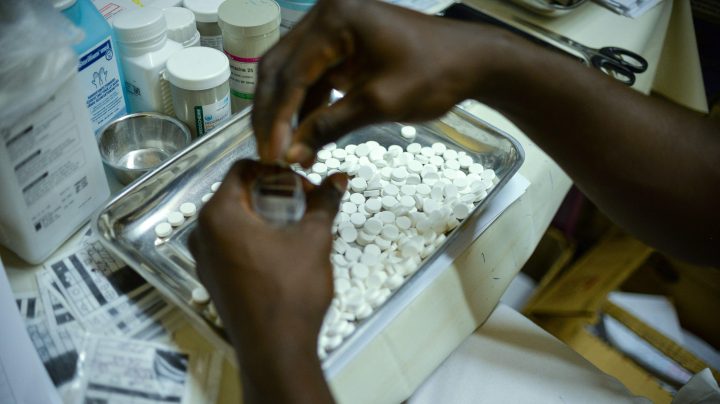
From AIDS to COVID: lessons and legacy

On March 11, 2020, the World Health Organization declared the COVID-19 outbreak a global pandemic.
Over those two years, the pandemic has frequently been compared to the Spanish flu contagion of 1918. It hasn’t been compared as often to the HIV/AIDS pandemic, which emerged in the early 1980s and devastated communities, and some national economies, around the world. But that pandemic did have significant impacts on public health, public opinion and drug research and development that have influenced the course of COVID-19.
COVID-19 has killed more than 950,000 Americans in two years, according to the U.S. Centers for Disease Control and Prevention. Since HIV/AIDS emerged, it’s killed about 675,000 Americans.
The two pandemics have a key thing in common, said Dr. Robert Wachter, chair of medicine at the University of California, San Francisco, and author of “The Fragile Coalition: Scientists, Activists, and AIDS”: “A virus that we knew nothing about in the beginning — causing tremendous panic and consternation in society.”
HIV/AIDS was both mysterious and 100% fatal early on. But in part because of who HIV/AIDS infected most commonly — gay men — public attention and government funding were slow to develop. By the late 1980s, though, national health leaders were sounding the alarm, as Dr. Anthony Fauci, director of the National Institute of Allergy and Infectious Diseases (a position he holds today), stated at a public appearance in 1987: “The pattern is that it’s clearly being established as a worldwide epidemic.”
But it took a wave of grassroots advocacy and protest by gay men and their allies, in groups like ACT UP, or AIDS Coalition to Unleash Power, and Gay Men’s Health Crisis, to push AIDS research into high gear. “AIDS activism basically taught us the role of patient-centered and patient-driven activism in driving a scientific agenda,” Wachter said.
New research funding and new Food and Drug Administration rules and protocols led to revolutionary antiretroviral drugs that eventually turned AIDS into a manageable chronic disease for most patients.
Fast-forward to 2020: The FDA and the National Institutes of Health were able to respond quickly and nimbly to the COVID pandemic, fast-tracking clinical trials and emergency-use authorization for tests, treatments and vaccines.
Yale epidemiologist and AIDS activist Gregg Gonsalves pointed out that many of the key figures who have led the research and public health response to COVID— including Fauci, CDC Director Dr. Rochelle Walensky and Dr. David Kessler, the White House’s chief science officer for COVID response, cut their teeth in the earlier pandemic. Gonsalves said they were “all HIV veterans leading agencies during the height of the AIDS pandemic.”
And, he added, there’s a direct line connecting the scientific investigation and discovery as well: “Basic research, a lot of the infrastructure for vaccine evaluation, investments into infectious disease paid for by AIDS research in the NIH, really paved the way for our mRNA vaccines.”
Gonsalves argued that there’s one crucial public-health lesson the country seems not to have learned from its experience with HIV/AIDS: People who are marginalized and stigmatized in society will suffer the most and wait the longest for help. “In a certain way, it’s like deja vu all over again,” he said. “When the AIDS pandemic started, it was thought of as a disease of disposable people — that it was gay men, Haitians, hemophiliacs. People that no one wanted to pay attention to.”
In the COVID pandemic, Black and Latino communities have suffered the highest case and death rates, according to data from the CDC and the Kaiser Family Foundation. That’s in part because of the low-wage, face-to-face service work people in these communities tend to do, and partly because of inadequate health care, said Aishah Scott, assistant professor of Black studies and health policy at Providence College.
“What we see here are gaps in access to care,” said Scott, “lack of access to quality health care, to quality employment, to quality education. These are the social determinants of health, and they’ll continue to reproduce themselves over and over again.”
Scott said grassroots organizations that emerged in response to HIV/AIDS are again rushing in. “The National Black Leadership Commission on AIDS, which is now known as the National Black Leadership Commission on Health, has been tapped to help, to get information to people in marginalized communities —about COVID, the COVID vaccine, how folks can protect themselves. They’ve been distributing masks and different resources.”
Scott added that leaders of civic, religious and activist organizations have stepped up to try to build trust and promote public health measures in communities of color as they’ve seen COVID devastate their families and neighborhoods. “These organizations are still necessary because we haven’t created public health infrastructure that fills the gaps,” she said.
There’s a lot happening in the world. Through it all, Marketplace is here for you.
You rely on Marketplace to break down the world’s events and tell you how it affects you in a fact-based, approachable way. We rely on your financial support to keep making that possible.
Your donation today powers the independent journalism that you rely on. For just $5/month, you can help sustain Marketplace so we can keep reporting on the things that matter to you.

















